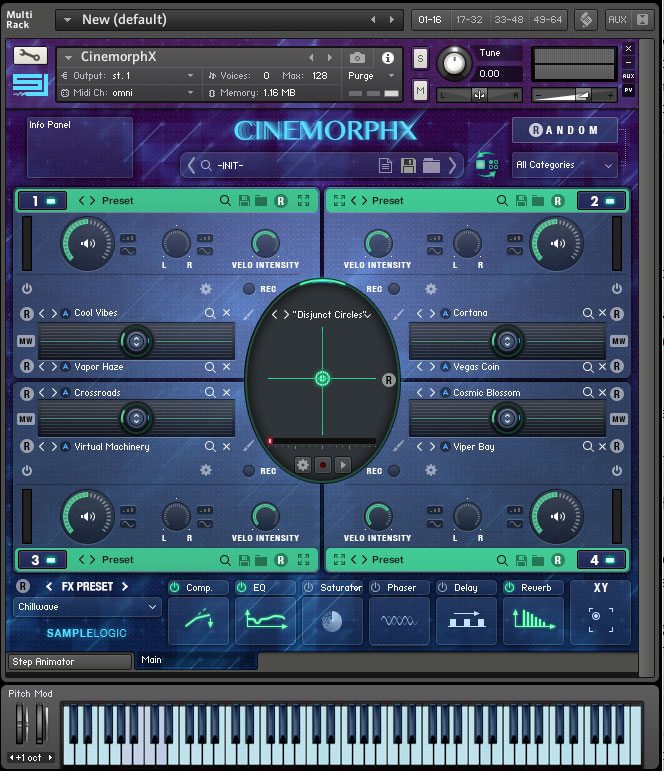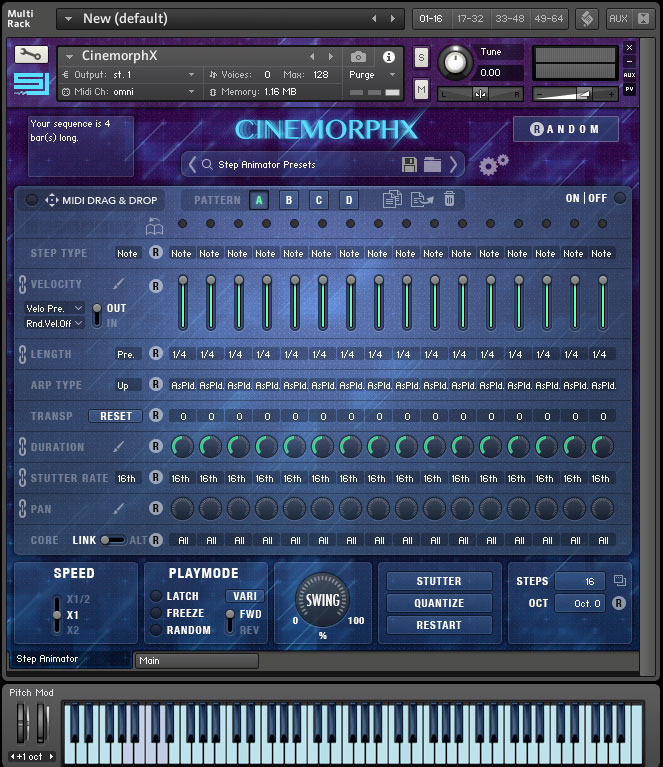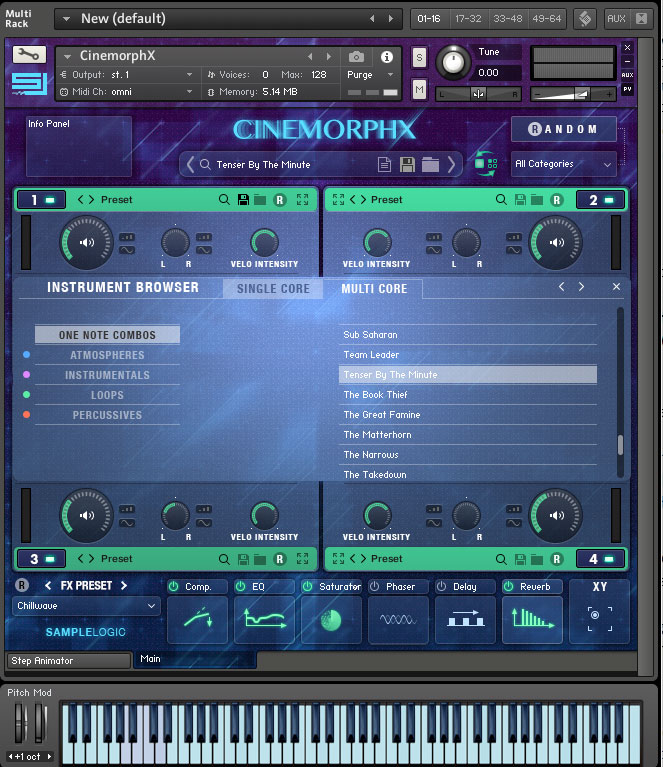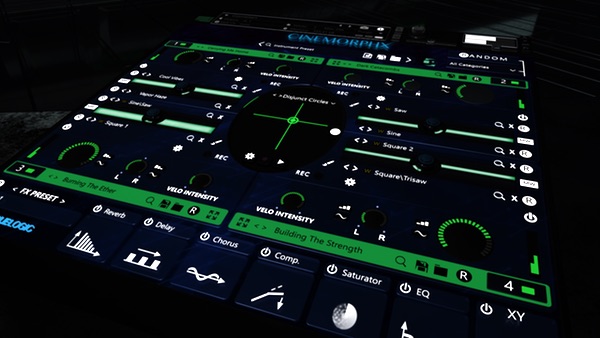Last Updated on June 12, 2016 by Andrew Culture
A massive set of samples and an even massiver set of ever-morphing sounds for Native Instruments’ Kontakt 5
Product: Cinemorphx
Manufacturer: Sample Logic
Web: https://www.samplelogic.com/
Price: $599 (cross grades available)


First things first. It’s a big download at around 30Gb so possibly an overnight job if you don’t have a fast internet connection.
So is the wait worth it? Let’s find out.
Cinemorphx is billed as The Complete Composer’s Toolkit.
It’s a combination and expansion of three of Sample Logic’s legacy products – AIR (Ambience Impacts Rhythms), The Elements and Synergy.
As you can imagine from the names, the packs are aimed at film, TV and game composers so that might give you an idea of the types of sounds you’ll find here.
The morph the merrier
And the sounds are big! And they evolve or morph. In fact, morphing is one of the software’s main features. The name gives it away, doesn’t it?
Cinemorphx runs in Native Instruments’ Kontakt sampler and can operate as a plug-in. It can even run in the free Kontakt Player if you don’t have or want to buy the full version.
There is only one instrument which can take a while to load initially. There’s much to be said for using a SSD when using Kontakt or any sample-based instrument.
From this one instrument you can access all the presets, and save and load new sounds.
The user interface is attractive in a sci fi sort of way and relatively easy to navigate. The 27-page manual quickly explains the operation and buyers can access a free set of tutorial videos, too.
At its core
Essentially, Cinemorphx works like this:
There are four soundcores located at the four corners of the main screen. Each core can hold two sounds (a set of keymapped samples) and a “3D Mixer” enables seamless morphing between the four cores.
There are around 6000 presets accessed from the Instrument Browser. They are divided into Single Core and Multi Core. Single Core is simply one soundcore (one or two keymaps) whereas Multi Core is all four (up to eight keymaps).
The presets are broadly divided into four categories: Atmospheres, Instrumentals, Loops, and Percussive. The Multi Core category has an additional One Note Combo.
If you were to audition each one for about 15 seconds each – and many take longer than that to evolve – it would take over 24 hours to listen to them all!
Sonic distractions
But you won’t be able to run through them one after the other anyway because you’ll get distracted by the other features. Guaranteed!
For example, the most tempting button is the XY control in the centre of the screen. It’s switched on for some sounds but not others so you’ll want to try it with those.
The XY control morphs between the soundcores. There are 20 morph presets and several adjustable controls if you want to delve deeper. You can make every sound move and evolve if you wish.
Very effective
At the bottom of the screen are six effects boxes which can each display one of 20 effects such as EQ, formant control, compression, saturation, delay, chorus, phasing and reverb. These are easily selected, adjusted and switched on and off.
It’s easy to change the presets on any of the cores so you can quickly change the sound mix.
And these are just the obvious controls.
In Step
In a second screen, the Step Animator is a multi-step sequencer – up to 128 steps – which can control several parameters including velocity, length, arpeggio type, duration, stutter effect and pan. There’s a Swing control, octave and transposition settings.
This can totally change the character of a sound as well as letting you create little riffs, movements and arpeggios.


Quoth the Raven – Ever Morph
And there’s yet more.
With the Morph Animator you can change the mix between soundcores and record morphs between them.
There’s also an FX Animator which morphs, yes, the FX.
And if you delve into the XY control a little more you’ll find a range of controls for adjusting the way it performs, too.
Yes, the morphing just goes on and on.


Roll a six
And in case you’re searching for inspiration or are just feeling a little lazy, there’s a superior Random function.
Virtually all the main parameters – and many minor ones – can be selected for randomisation. This includes, of course, selecting the samples for the soundcores and an additional filter lets you specify the category (Atmosphere, Instrumentals, and so on) they come from.
Just about every setting in the Step Animator can be randomised, too.
Heck, you just have to set everything to random to see what happens! That’s a week’s worth of experimentation alone.
The guys at Sample Logic calculated that there are about an octillion sound combinations (yes, I had to look that up!) Whatever that is, it’s a lot!
Niggles?
Yes, a few little ones.
The main categories – Atmosphere, Instrumentals and so on – each have five or six further subdivisions but that’s as deep as it goes. The sounds have cute/interesting names but they don’t tell you what type of sound they are which makes it difficult to home in on a specific sound you might want.
When presented with so many sounds, you appreciate the comprehensive tagging in Native Instruments’ Komplete Kontrol and Maschine.
See also “Making MorphX” for more about sound selection.
And if we’re being picky then it’s slightly frustrating that the mouse wheel doesn’t scroll through the sound list; instead you have to click and drag on the scroll bar which is pretty thin.
Also – this is the last niggle – there is a degree of similarity between some sounds but given the nature of the instrument perhaps that’s to be expected.
Summary
Cinemorphx is unbelievable fun!
Some sounds could easily stand on their own or as a track that you could build a song or sound segment around. Movie composers could possibly create sections of a score simply from one key press!
Aside from the fact that it would take an age to explore the presets alone, it will take even longer to explore the range of options offered by the adjustable parameters.
But note, it’s just the wealth of possibilities that will take time to explore; the system is not at all difficult to use or to fathom out.
Although the name suggests Cinemorphx is for cinematic producers, to restrict it to those genres is to do it a disservice. Anyone working in electronica or EDM could undoubtedly draw inspiration from it – see “Making MorphX”
Is this a desirable piece of kit and do you want it?
Yes!
Apart from the issues around sound selection, the major negative is the price. However you look at it, 600 bucks is a lot for a piece of music software. You can buy complete orchestral instrument sets for less.
It firmly puts it in the high-end category and defines the type of musician and composer that Sample Logic expect to use Cinemorphx, and for those it will be sample/cinematic/atmospheric/sound design heaven and how do you put a price on that?
But it’s difficult to imagine any type of music or composer that wouldn’t salivate over this set of sound generation possibilities. I was listening to it with half an EDM ear and there were beats and build-ups all over the place.
If you’re a fan of evolving, changing textures it’s something you need to check out.


Making MorphX
Given the range of sounds in Cinemorphx, I thought it would be interesting to try to create a piece of Dance Electronica using nothing but the presets.
The first task was to find some suitable drum, bass and effects loops. There were many candidates so the second task was to see which ones fitted well together.
Next job was to find melodic loops that fit. I could have created them with the Step Animator but I wanted some ready-made.
I confess I probably haven’t been though all 6K of the presets but most patterns were more sequence-like than melodic (if you see what I mean) but I found a few I thought I could use.
Finally there were the fills and toppings and several presets offered a range of different hits keymapped across the keyboard.
Then came the fun part of putting them together in some kind of song format.
I used nine presets in total, unmodified with no additional effects.
If you like it – great – if not, blame me, not Cinemorphx.
Oops!
I did experience one problem. After a ‘mishap’ for which no piece of software can be blamed, I needed to load the presets again.
I knew the names but not which sections they were under or even if they were Single or Multi Cores.
Nope, there’s no search function, nor can you list ALL the presets. So if you want to find a particular sound, unless you know which Core and category(ies) it’s under, it could take a while. It took me almost two hours!
Lack of a search function, good tagging, an ‘all presets’ list, and mouse scrolling make for poor preset navigation and take a lot of shine off a superb sound set.
With hindsight, of course, I should have saved the presets individually and the whole as a Multi as I was going along – guess what I did second time around! – but having to note preset locations distracts from the workflow.

















